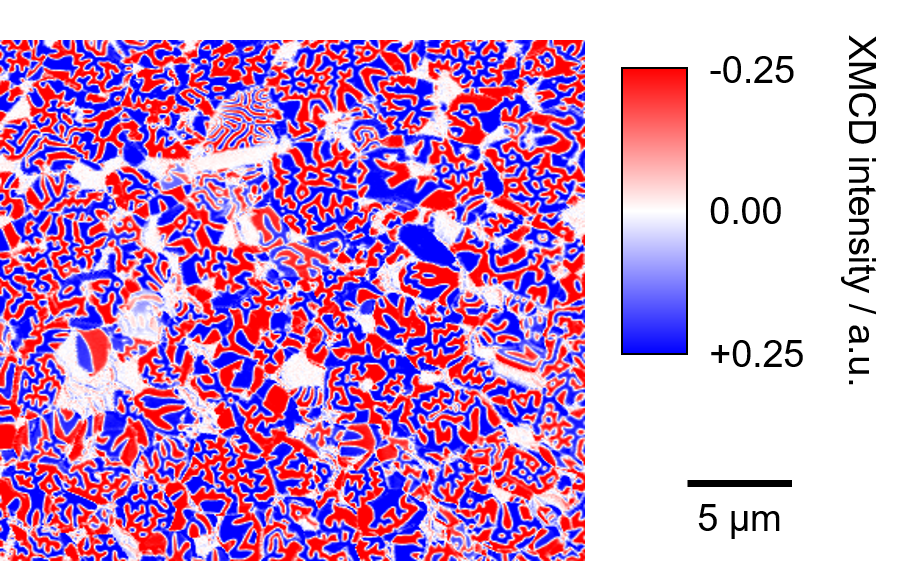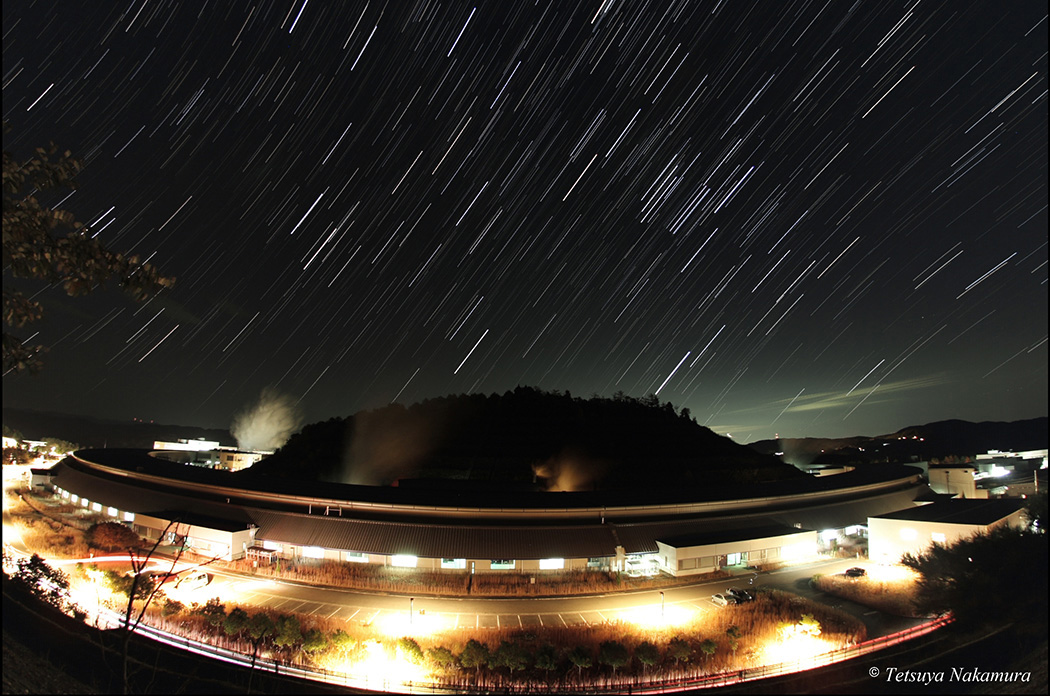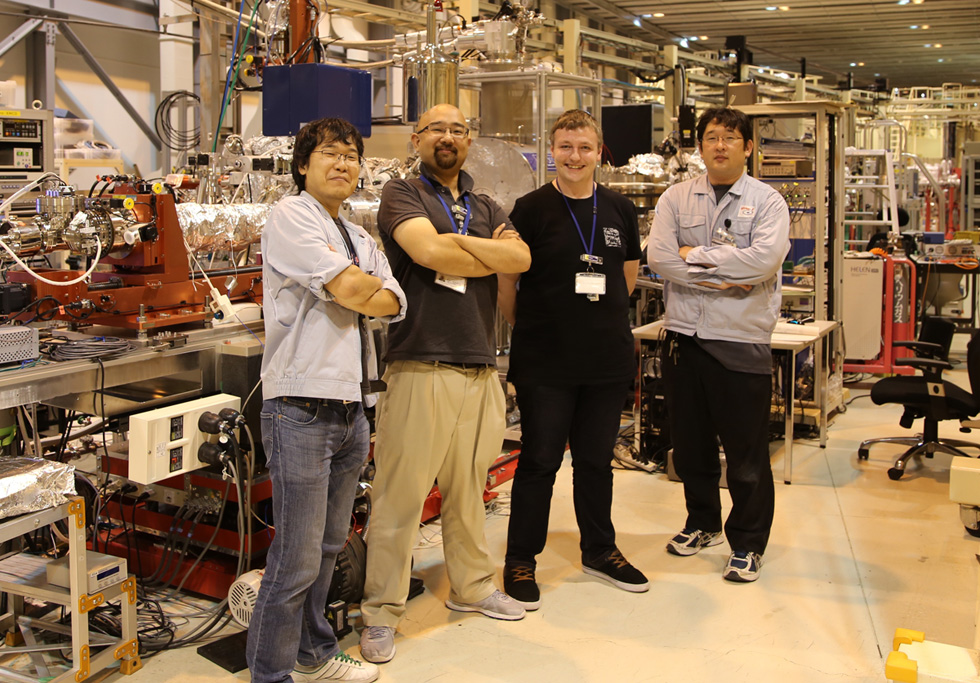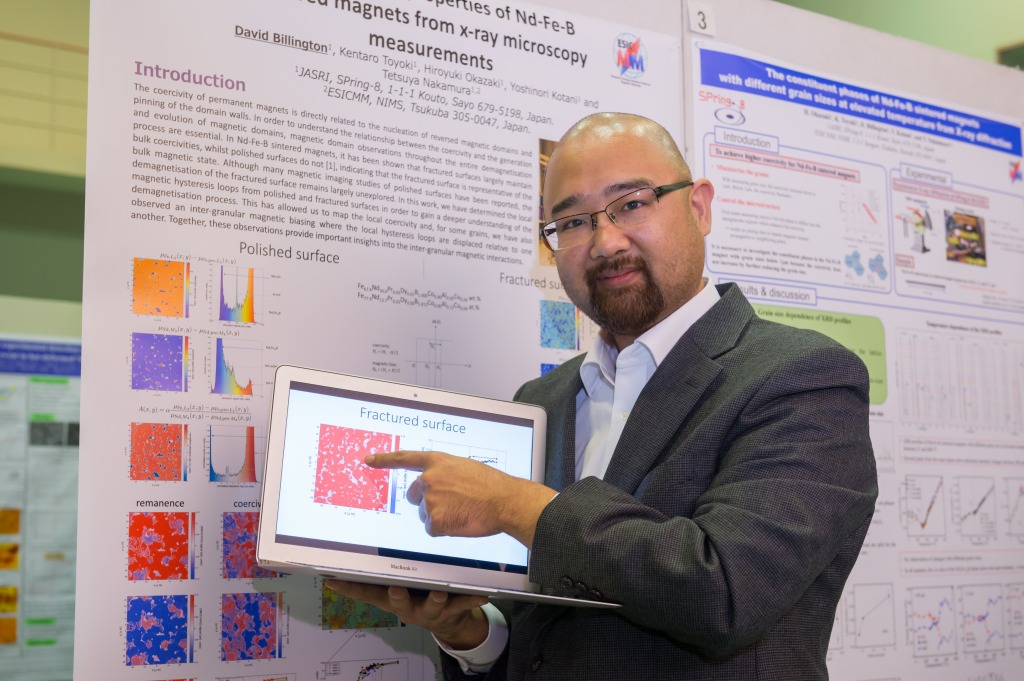Elements Strategy Initiative WEB
Talking to a Young Researcher
Dr. Toyoki operates the SXM.
The young researchers working on the frontline of the Elements Strategy Project.
What do they envisage in the future, and what kinds of challenges are they taking on?
- What kind of research are you doing?
- Please tell us about your day-to-day activities
- What are you particular about and what is your stance as a researcher?
- What themes will you approach in the future?
- What comes to you when you think about the future of Elements Strategy?
- from David
- From the Interviewer
What kind of research are you doing?
We’re searching for the mechanism behind the coercivity of permanent magnets by investigating the microstructure using magnetic imaging.
The main part of the research involves magnetic imaging using a scanning soft x-ray microscope (SXM). Basically, the sample is irradiated by soft x-rays and the electrons coming out of the sample are measured and converted into an image.
When you look at magnetic materials on the atomic scale, “magnetic domain” regions in which the direction of magnetization of individual atoms (N pole and S pole) are aligned are combined to give the observable magnetism. The stronger the force (coercivity) maintaining the magnetized direction, the harder it is to eliminate the force that attracts things. However, if the coercivity is weak, the magnetization starts to reverse in response to small magnetic fields with the opposite direction or heat, and the magnetic force drops easily. The SXM is necessary to investigate where and how the reversal of magnetization occurs.
The SXM we are using is a high-performance type developed by the Elements Strategy Initiative. Conventional magnetic microscopy methods involve looking at flat polished surfaces or thin films, a state in which the coercivity is low. Instead, our SXM has been designed to observe the fractured surface whose coercivity is maintained. We can then apply a strong magnetic field of up to 8 T which can overcome the force aligning the magnetic field of the permanent magnet. As a result, we can now see the magnetic domains in detail over a wide area.
Our ongoing goal is to elucidate the mechanism of coercivity through further detailed research in order to improve the performance of magnetic materials and to develop new ones.

The magnetic domain pattern of a neodymium magnet.
Red and blue correspond to N and S poles, respectively.
Please tell us about your day-to-day activities
I am making every effort to improve equipment with the aim of enabling measurements that can be performed by pressing a single button.
First of all, we need to develop, improve, and maintain the equipment. SPring-8 is an open research facility that can be used by universities, research institutions, and corporate researchers. Many of the researchers in the Research & Utilization Division to which I belong are involved not only in the research theme that I’m working on, but also management and operation of the public beamline, as well as support for the advanced research being undertaken by its users. On the other hand, as a postdoctoral researcher in the Elements Strategy Initiative, I must also concentrate on magnetic research.
However, in addition to developing and improving the measurement methods for this research, we’ve created image analysis programs for the magnetic imaging, and developed software for specific analytical requirements, which have ultimately been very useful for the experiments of other users. In recent years, the measurements have become faster, in the order of one pixel per microsecond, so it’s also necessary to consider communication speed.
I was assigned here two years ago, and I felt that the synchrotron radiation facilities were unique. In ordinary laboratories, it takes new people one or two years to be able to operate the equipment. But because they only use synchrotron radiation facilities for about three days in a half year period, they can’t remember how to operate the equipment. I have to show them, but I’d like to make it possible for people to understand to some extent, without having to be shown. Ultimately, I want to make it possible to perform a measurement by simply pressing a single button. We’re doing research with a focus on collaborative research with our many colleagues in the Element Strategy Initiative.

SPring-8 storage building. Various experiments using world’s brightest synchrotron radiated light can be achieved.
What are you particular about and what is your stance as a researcher?
If I say “I can do this”, I think hard until I reach the point where I can say “I’ve done it!”
I think this research suits me. That’s because when I went to university, the research in the Faculty of Engineering that looked interesting to me was materials science and measurement technology. My doctoral dissertation was about research on the Cr2O3 spintronic material.
As soon as I finished my doctoral course, I went to SPring-8, but at that time, the magnetic imaging technology here was completely new. Since basic measurements with the SXM had only just become possible, the priority was given to hardware, and development of the software for visualization of the measured data remained a future project. I’ve always been good at programming and making software, and I had experience in developing software for measurement and so on so, as part of my magnetism research, I began working on software development by myself. Now I’m doing all of the software development!
SPring-8 SXM magnetic imaging is top class for its absence of noise. It’s becoming commonplace to hear people say “it’s amazing to be able to see things this clearly!”, but actually I’d like to hear what they’re unsatisfied with so that I can put it to use in future development.
I’m often asked, “What did you have difficulty with?”, but once you’ve achieved something, you tend to think of the achievement as a matter of course, so my answer is always rather detached. But actually, if somebody says, “Can it be done or not?”, I always answer, “Yes, it can”, then I beat my brain trying to get it done!
What themes will you approach in the future?
I intend to devote my whole life to the development of technologies function on timescales of nanoseconds to hundreds of seconds.
I intend to continue my research on magnetism. In order to elucidate the mechanism of coercivity, it’s necessary to identify the process by which reverse magnetic domains occur. However, we can’t tell when it will occur due to random thermal fluctuations. Consequently, we have to comprehensively observe an exceedingly wide range of time scales, starting from the nanoseconds of the trigger, to hundreds of seconds. On the spatial scale, magnetization reversal of several hundred atoms represents the trigger, which spreads to the length scale of centimeters. Since it’s difficult to see the whole thing at once, it’s necessary to measure it hierarchically and put the parts together.
I suppose that developing technology for measuring a phenomenon that lasts from a nanosecond to several hundred seconds when you don’t know when it will occur will require more time than my lifetime. However, the significance of this development is that it will lead to fundamental solutions to the problems of phase transitions and chemical reactions of various substances, not only in magnetic research. I think this will be the starting point for clarifying a variety of issues.
What comes to you when you think about the future of Elements Strategy?
The periodic table of elements provides a signpost for research.
When considering the future of Elements Strategy and materials science, we’re always trying to utilize the full periodic table of the elements. When considering what kind of material is good, using plentiful elements is best, so I always think it would be good if we could make do with just iron, silicon, and carbon, plus oxygen and nitrogen. I’m glad that magnetism is available with cheap iron. If it didn’t come with iron, we probably couldn’t have used it.
When I look at the periodic table every day, even though I couldn’t remember that much during my high school days, I’ve started to learn it naturally. As a researcher in materials science, since the upper and lower elements are similar, we think of using them by combining this and that. Since we’ve been able to use soft x-ray beamlines, we’ve begun to think in terms like, since praseodymium is to the left of neodymium, the energy at the M absorption edge is about half the 900 eV level and overlaps with the copper L absorption edge. The periodic table is the basis of Elements Strategy.
from David

Dr. Toyoki and his colleagues. From the left, Dr. H. Okazaki, Dr. Toyoki, Dr. D. Billington, and Dr. Y. Kotani.
Toyoki-san and I both started our postdocs at SPring-8 in October 2015. Together, we have performed a number of magnetic microscopy experiments on Nd-Fe-B sintered magnets as part of the Element Strategy project. During this time, the measurement speed has vastly increased thanks to improvements in the experimental method and processing software made by Toyoki-san. This has made many measurements possible that we could not do previously. Working with Toyoki-san has been an absolute pleasure and I hope to collaborate with him in my future career!
Profile

A poster review on the ESICMM report meeting.
Dr. Kentaro Toyoki
Japan Sychrotron Radiation Research Institute (JASRI/SPring-8) Postdoctoral Researcher, Spectroscopy Group II, Research & Utilization Division
September 2015:
Completed PhD from the Division of Materials and Manufacturing Science, Graduate School of Engineering, Osaka University
October 2015:
Became a postdoctoral researcher at Japan Synchrotron Radiation Research Institute (JASRI/SPring-8)
Interviewer’s Postscript
Dr. Toyoki proceeds with his own research while also working on the development and the maintenance of cutting-edge equipment. While he admits that simultaneously conducting these three processes is not easy, he highly values the various opportunities for communication he has including those with the many external researchers who visit to use the SPring-8 facility. He is also an enthusiastic participant in seminars in different fields involving magnetics and study groups within the synchrotron radiation facility. He very much enjoys chatting with people in the rest area at the facility. This sort of interaction provides him with intellectual nourishment, which he appears to be using to cultivate his research ideas.
(Dr. Toyoki was interviewed by Sakiko Fukushima of Sci-Tech Communications)
Dr. Billington cooperated with a native check / Photo:Michito Ishikawa/Tetsuya Nakamura